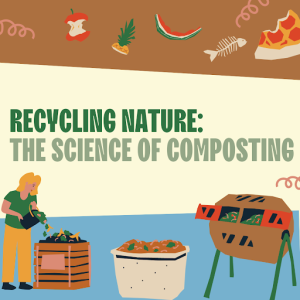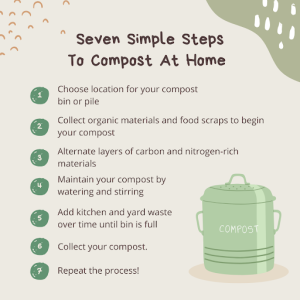Recycling Nature: The Science of Composting
By Ella Coley, C2ST Intern, Waubonsee Community College
The United States throws away nearly 60 million tons of food each year. We produce more food waste than any other country in the world, equaling 325 pounds of garbage per person. It’s like everyone in America throws 6 and a half large packed suitcases directly into a landfill. According to the United States Environmental Protection Agency, when food and other organic materials break down and decompose in an environment that lacks a flow of oxygen, the bacteria that break down the food begin to emit greenhouse gases such as methane, carbon dioxide, and chlorofluorocarbons, all of which contribute to global warming. Wasted food in landfills across the United States emits greenhouse gases equivalent to the emissions from 37 million cars, according to the World Wildlife Federation. One solution that can help reduce the amount of food waste sent to landfills and reduce greenhouse gas emissions is composting.

Composting is the process of turning organic materials such as food scraps, dry leaves, and woody material into a nutrient-rich product that can be added to soil or mulch. It is also known as nature’s way of recycling and is a powerful way to reduce waste and address climate change. These factors all contribute to helping build healthy soil for your garden or community.
Composting has many benefits on both small and large scales. In your living space, composting can benefit you by providing improved air quality due to the lack of food waste in the garbage which also helps keep away odors and unwanted pests. For those with house plants or a backyard garden, composting helps add nutrients to the soil, promoting the health of your plants and crops. Using compost in the garden can also help save money by conserving water and reducing the overall cost of project maintenance in your yard due to its water retention and nutrient-dense properties. On a larger scale, composting has benefits, such as preventing soil erosion and helping control stormwater management by controlling water’s flow through and on the soil. It also helps combat climate change and greenhouse gas emissions by reducing waste sent to landfills. Additionally, large-scale composting can assist with wetland reclamation by providing organic material to those ecosystems.
After hearing about the many benefits of composting, you may be wondering how composting works and how to get started yourself. The composting process requires three main parts: water, oxygen, and organic matter (such as food scraps, leaves, plants, coffee grounds, egg shells, etc.). Composting is the process that uses microorganisms and bacteria to eat the organic matter and waste. The microorganisms decompose the matter through a process called aerobic respiration. With the help of oxygen and water, they break down the organic material into its simplest parts containing fiber and nutrients such as nitrogen, phosphorus, and potassium. Oxygen and water are needed for the microorganisms to live, multiply, and give off carbon dioxide and heat to continue the decomposition process. While there is some greenhouse gas production throughout composting, the environmental impact is much less than in landfills. When organic materials are composted, the main greenhouse gas emitted is carbon dioxide which can be recycled into the atmosphere after being absorbed by plants. However, in landfills, there is about half carbon dioxide and half methane, methane is more harmful since it traps 25 times more heat than carbon dioxide and cannot be recycled.
Although composting is usually thought of as an activity done by serious gardeners who have enough yard space to dedicate to a compost pile or bin, technological advancements in composting products and systems have allowed for higher accessibility to those who live in a smaller space or simply want to compost to help the environment or local farmers. Whether through systems that take your food scraps and turn them into compost for you, or new products that make in-home composting easier, composting is becoming more accessible to the public regardless of yard space.
There are many ways to get started with composting at home. I’ve shared a few below
If you have a backyard or garden, you can easily compost the traditional way by creating a pile. You can start a compost pile by placing your scraps and organic matter in a heap or container in a location that receives adequate sunlight and is near a water source. To maintain the compost pile, you’ll need to “turn” (aka mix) it regularly to ensure there’s proper aeration and moisture throughout.

Some products and methods allow for composting indoors or in an apartment such as vermicomposting (a process that uses worms to aid in the decomposition), bokashi (a fermentation process that allows you to compost materials such as meat and dairy that traditionally aren’t composted), and small scale or countertop compost bins. All you need to get started is a bin with drilled holes, your organic plant and kitchen scraps, and some worms to decompose the compost. Many products on the market allow for in-home electric composting without using worms if that’s more suitable for your lifestyle.
Find a Composting Community or Service
The easiest way to compost without much effort is to simply save your food scraps in the freezer and then bring them to a facility, community garden, or farmer’s market that would compost them for you. There may even be a residential compost service provider in your area who can collect your scraps, turn them into compost, and return them to you to use in the soil or garden.
To sum things up, composting has many benefits for both individuals at home and the environment. It promotes better air quality, reduces greenhouse gas emissions, and decreases the amount of waste produced by households across America. Whether you have a small or large living space or backyard, you can help give back to the earth by composting!
References
- https://www.compostingcouncil.org/page/CompostBenefits
- https://bungalow.com/articles/how-to-compost-in-an-apartment-everything-you-need-to-k
- https://home.howstuffworks.com/composting.htm#:~:text=During%20composting%2C%20microorganisms%20eat%20the,material%20down%20through%20aerobic%20respirati
- https://www.epa.gov/recycle/composting-home
- https://www.epa.gov/sustainable-management-food/composting
- https://www.rts.com/resources/guides/food-waste-america/#:~:text=Here%27s%20some
- https://bootstrapcompost.com/how-to-take-advantage-of-compost-in-your-home-or-apartment/#:~:text=By%20composting%20food%20scraps%20and,unwanted%20pests%20in%20the%20process
- https://mygreenbin.in/
- https://www.chicago.gov/city/en/sites/chicago-recycles/home/food-scrap-drop-off.html#:~:text=Hey%20Chicago%2C%20let’s%20compost!,across%20the%20city%E2%80%93%20for%20FREE!